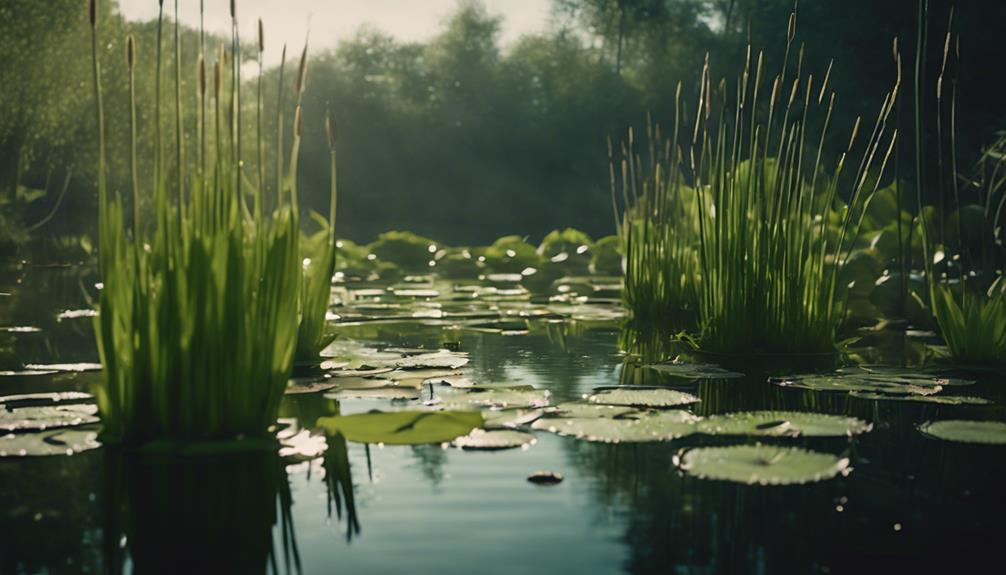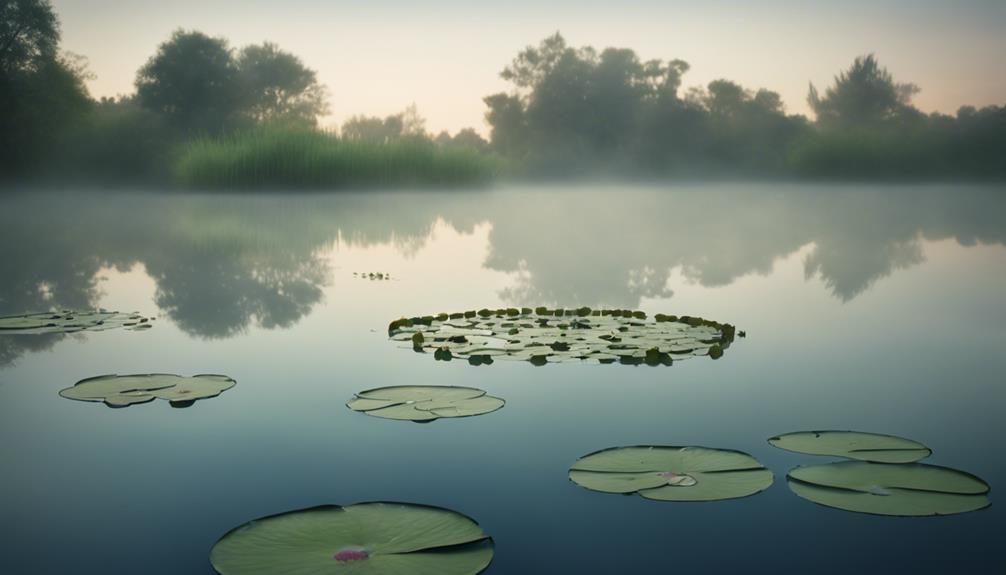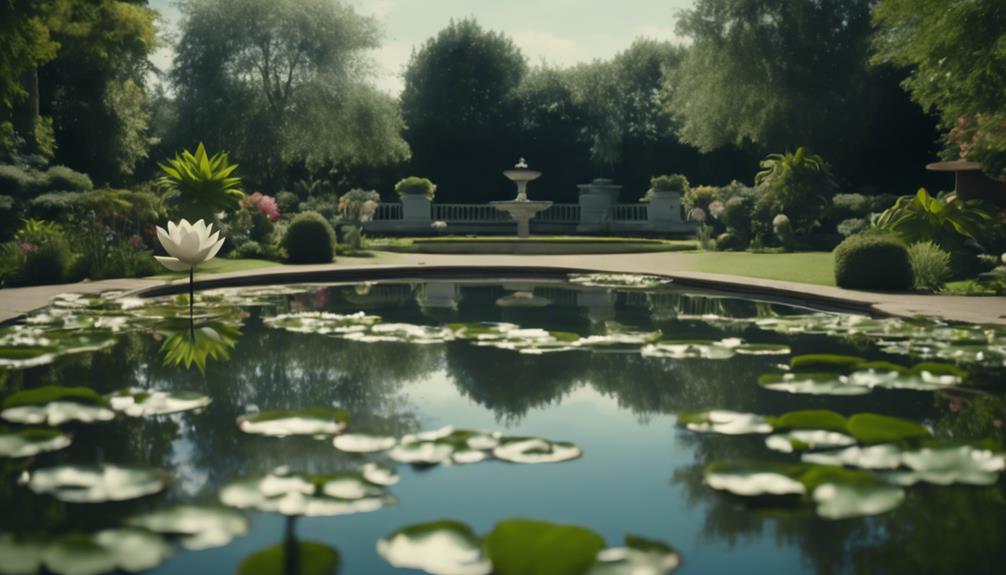You can achieve a healthy balance in your pond's water chemistry by following five essential tips. First, maintain a balanced fish population to prevent overcrowding and water quality issues. Next, feed your fish wisely to avoid overfeeding and excess waste. Adding diverse aquatic plants will boost oxygen levels and support beneficial microbes. A well-designed pump and filter system will guarantee proper water circulation and filtration. Finally, maintain a stable water temperature between 25°C and 28°C to prevent overheating and stress in pond fish. By following these tips, you'll be well on your way to creating a thriving ecosystem, and there's even more to discover about maintaining a healthy pond.
Table of Contents
Key Takeaways
- Maintain a balanced fish population by rehoming excess fish and following the 1 inch of fish per 2 square feet of surface area rule.
- Feed fish wisely by regulating the amount and frequency of feedings to prevent water quality issues and waste production.
- Integrate diverse aquatic plants to enhance oxygen levels, support beneficial microbes, and create a healthier environment for fish.
- Ensure proper water circulation and filtration with a well-designed pump and filter system that can handle more than the pond's capacity.
- Maintain a stable water temperature between 25°C (77°F) and 28°C (82°F) to support beneficial microbes and prevent overheating and stress in pond fish.
Balanced Fish Population Matters
Maintaining a balanced fish population is essential to prevent water quality issues, as overcrowding can lead to an imbalance in pond water chemistry.
As a pond owner, you play a vital role in ensuring a healthy ecosystem. Having more than 10 fish per 100 gallons of water can lead to over-population, causing an imbalance in pond water.
Excessive fish waste increases the amount of ammonia in the water, which can be toxic to fish.
To maintain a balanced fish population, consider rehoming excess fish to prevent overcrowding. A good rule of thumb is to add no more than 1 inch of fish per 2 square feet of surface area in the first year.
By doing so, you'll prevent water quality issues and maintain a stable food chain. Remember, a balanced fish population is essential for a healthy ecosystem.
Feed Your Fish Wisely
By regulating the amount and frequency of fish feedings, you can substantially impact the overall health and balance of your pond's ecosystem.
To feed your fish wisely, avoid overfeeding, which can lead to water quality issues. Overfeeding can cause excess food to decay, releasing ammonia, nitrite, and nitrate into the water, harming your fish and beneficial bacteria.
Instead, feed your fish no more than they can eat within five minutes, and limit feedings to twice a day in the summer season. A general rule of thumb is to feed your fish 1-2% of their body weight in food per day, divided into 2-3 meals.
Monitoring your fish's feeding habits and adjusting the amount accordingly is vital to maintaining a balanced ecosystem. By doing so, you'll prevent waste production, keep your water clean, and see to it that your pond filters and filtration system can function efficiently.
Regular water testing will also help you identify any potential issues before they become major problems, allowing you to make adjustments to your pond management strategy as needed.
Plant Life for Oxygen Boost

Integrating a diverse range of aquatic plants into your pond's ecosystem can substantially enhance oxygen levels, creating a healthier environment for your fish and beneficial bacteria.
As you introduce these plants, you'll notice a significant boost in oxygen production, which in turn supports the growth of beneficial microbes.
These microbes play a vital role in breaking down organic matter, keeping your pond's water clean and healthy.
When selecting aquatic plants, opt for species that thrive in your pond's specific water conditions.
Consider plants like water lilies, cattails, or hornworts, which are known for their oxygen-producing capabilities.
As these plants grow, they'll absorb excess nutrients from the water, reducing the risk of algal blooms and maintaining a balanced ecosystem.
Pump and Filter Essentials
As you've optimized your pond's oxygen levels with aquatic plants, you'll want to guarantee proper water circulation and filtration to support the thriving ecosystem, which is where a well-designed pump and filter system come into play.
A pump that can circulate the entire water volume of the pond at least once every hour is necessary for proper water circulation and oxygenation. It's vital to make certain the pump's flow isn't restricted by debris in the skimmer or biological filter.
Choosing the correct pump size for the pond and waterfall is essential to prevent under or over-circulation, which can lead to water quality issues.
When it comes to your filter, sizing up to handle more than the capacity of the pond guarantees it can handle the water volume and maintain proper filtration.
Regular cleaning of the filter according to instructions is necessary for proper filtration and to prevent clogging, which can also lead to water quality issues.
Cooling Down for Health

Cooling Down for Health
Maintaining a stable water temperature is essential for your pond's ecosystem, and you'll need to take measures to prevent overheating, which can be detrimental to aquatic life. When water temps rise, it can lead to stress in pond fish, making them more susceptible to disease. Additionally, high temperatures can reduce oxygen levels, causing uneaten food to decay and creating an environment conducive to algae growth.
| Temperature Ranges | Effects on Pond Ecosystem |
|---|---|
| 25°C (77°F) | Beneficial microbes thrive, water clean and healthy |
| 28°C (82°F) | Pond fish start to stress, uneaten food begins to decay |
| 30°C (86°F) | Algae growth accelerates, water feature becomes unhealthy |
To keep pond water clean and healthy, consider adding shade-providing plants, using aeration systems, or incorporating water features that increase water circulation. These measures will help regulate water temps, creating a stable environment for your pond's inhabitants. By taking these steps, you'll be able to maintain a healthy pond, where pond fish can thrive and beneficial microbes can flourish.
Frequently Asked Questions
How to Balance Pond Water?
To balance your pond water, you'll need to monitor pH levels, prevent algae blooms, reduce fish stress, and consider water hardness, nutrient cycling, and beneficial bacteria.
How Do I Keep My Pond Water Healthy?
You're probably wondering how to keep your pond water healthy, and trust us, it's a million times easier than you think! By incorporating pond aeration, monitoring fish health, and controlling algae, you'll be well on your way to maintaining excellent water quality, nutrient cycling, and thriving pond life.
How Do I Maintain the Water Level in My Pond?
You should monitor your pond's capacity, accounting for water evaporation, level fluctuations, and water loss, while utilizing rainwater harvesting and overflow management systems to maintain a stable level, ensuring your pond liner is leak-free and adjusting for seasonal changes.
How Do I Keep My Pond Water Clear Naturally?
As you gaze into your pond's tranquil waters, you dream of a crystal-clear haven. To achieve this, you'll need plant filters to absorb excess nutrients, algae control through beneficial bacteria, and natural methods like sediment removal to maintain ecosystem balance and oxygen levels.
Conclusion
As you gaze out at your thriving pond, remember that maintaining a delicate balance is key.
It's a high-wire act, but with these 5 tips, you'll be walking the tightrope like a pro.
By keeping your fish population in check, feeding wisely, and incorporating plant life, you'll be well on your way to a harmonious ecosystem.
And don't forget to pump and filter regularly, and provide some cooling relief during hot summer months.
With these elements in sync, your pond will be a serene oasis, teeming with life.

